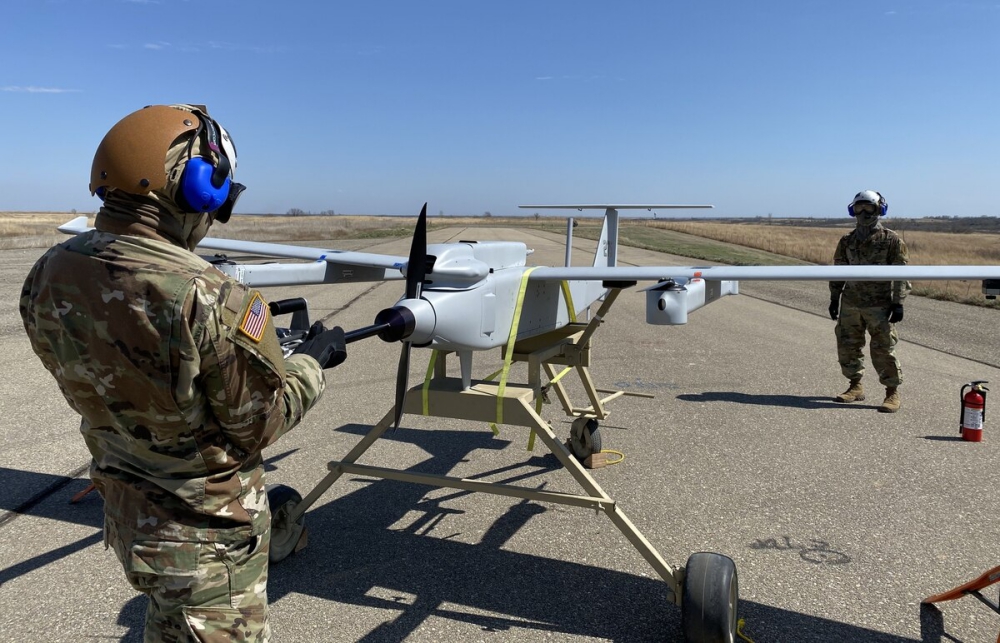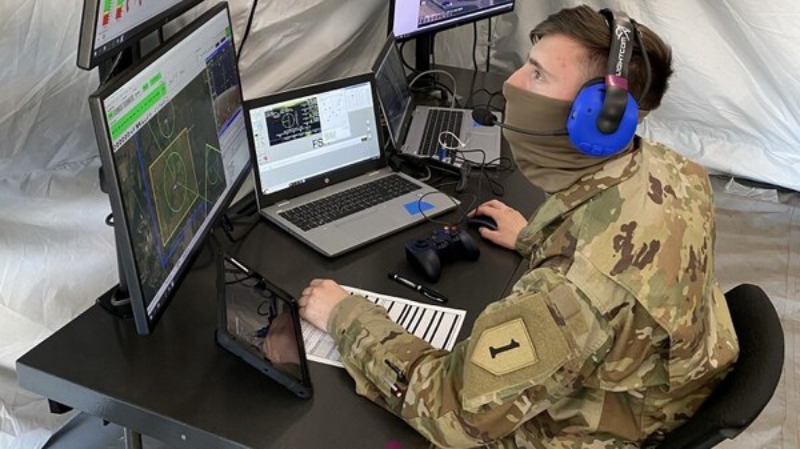
Spc. Christopher McCoy, assigned to 1st Engineer Battalion, 1st Infantry Division, conducts an engine start on the JUMP 20 prior to a launch during a capabilities assessment at Fort Riley, Kansas, on April 8, 2020
The first candidate in the running to replace the U.S. Army’s RQ-7 Shadow unmanned aircraft system had its first soldier-operated flight in an April 7 capabilities assessment.
The 1st Armored Brigade Combat Team, 1st Infantry Division flew the Arcturus UAV JUMP 20 at Fort Riley, Kansas.
It was uncertain whether the assessment would stay on schedule, according to an April 9 Army statement announcing the flight, due to precautions set out to prevent the spread of the new coronavirus, COVID-19. But the 1st ID’s commanding general, Maj. Gen. John Kolasheski, determined it could proceed with “proper mitigations” while following guidelines from the Centers for Disease Control and Prevention as well as the Defense Department to combat the spread of the virus.
The Army selected four unmanned aircraft systems in 2019 as candidates to replace the Shadow. The soldier assessments will also inform requirements for a future tactical unmanned aircraft system, or FTUAS, that would fit into a future vertical lift ecosystem to include new helicopters and other new, air-launched effects.

Spc. Nicholas Miller, assigned to 1st Engineer Battalion, 1st Infantry Division, conducts flight operations through a laptop-based ground-control station during the FTUAS capabilities assessment at Fort Riley, Kansas, on April 8, 2020
The service first selected two teams to provide systems for a competitive soldier-led evaluation in March 2019: Martin UAV and Textron’s AAI Corporation. Martin UAV has teamed with Northrop Grumman to provide its V-Bat UAS. Textron is offering its Aerosonde HQ.
But shortly after, the Army added two more aircraft to the mix: the Arcturus system and L-3 Harris’ FVR-90.
All the UAS went through a rigorous fly-off during December 2018 and January 2019 at Dugway Proving Ground, Utah. The competition helped the service select the systems that would proceed to the soldier-assessment phase.
The Army was looking for systems that improved upon the Shadow UAS’ performance, particularly better acoustics (Shadow sounds like a flying lawn mower) and runway independence (Shadow relies on a runway to take off and an arresting device to land).
There are five units that will assess the systems, while the fifth unit will have a second set of the Arcturus system. The reason for a second unit testing the Arcturus aircraft is “simply a math problem,” an Army spokesperson told Defense News earlier this year. “With four vendors and five [brigade combat teams], a decision had to be made to purchase a fifth system to meet the fielding, training and assessment schedule,” the spokesperson said.
The Arcturus UAV is the largest of the unmanned aircraft participating in the soldier assessments, weighing in at 210 pounds with an 18-foot wingspan.
“Despite the size, its reduced acoustic signature compared to the Shadow is appreciated by the entire crew,” the Army statement read.
We’re used to screaming at each other and having to use radios in order to communicate,” Spc. Christopher McCoy, a crew chief assigned to 1st Engineer Battalion, 1st ABCT, said in the statement. “You can stand right next to this aircraft and not even raise your voice.”
The JUMP 20 can also “launch and recover from a confined area with minimal ground support equipment,” according to Spc. Nicholas Miller, a UAS operator also assigned to 1st Engineer Battalion.
The soldiers in the unit will work with the UAS over the next five months. “The assessment utilizes a crawl, walk, run mentality, progressing through operator and collective training, then culminating in brigade level field training exercises and a Combat Training Center rotation,” the statement noted.
Units at Fort Campbell, Kentucky; Fort Lewis, Washington; Fort Bliss, Texas; and Fort Bragg, North Carolina, will evaluate the other UAS offerings from May through September, but the assessment schedules are “under regular re-evaluation as COVID-19 conditions change,” according to the statement.
The assessments of the four systems over the course of fiscal 2020 will help the Army decide how it would like to proceed in not only replacing the Shadow but also in acquiring an FTUAS system that will play an integral role in the future fleet alongside manned and optionally manned helicopters in advanced teaming.
“We are very focused on 2021 and seeing the outcomes,” Brig. Gen. Wally Rugen, who is in charge of the Army’s future vertical lift modernization efforts, said in 2019, “but our goal is that in 2021 that this could fully inform our requirement. And if things go tremendously, which they don’t always do, we are postured to exploit that success in 2021.”
Photos:Program Executive Office Aviation
Source: Defense News
